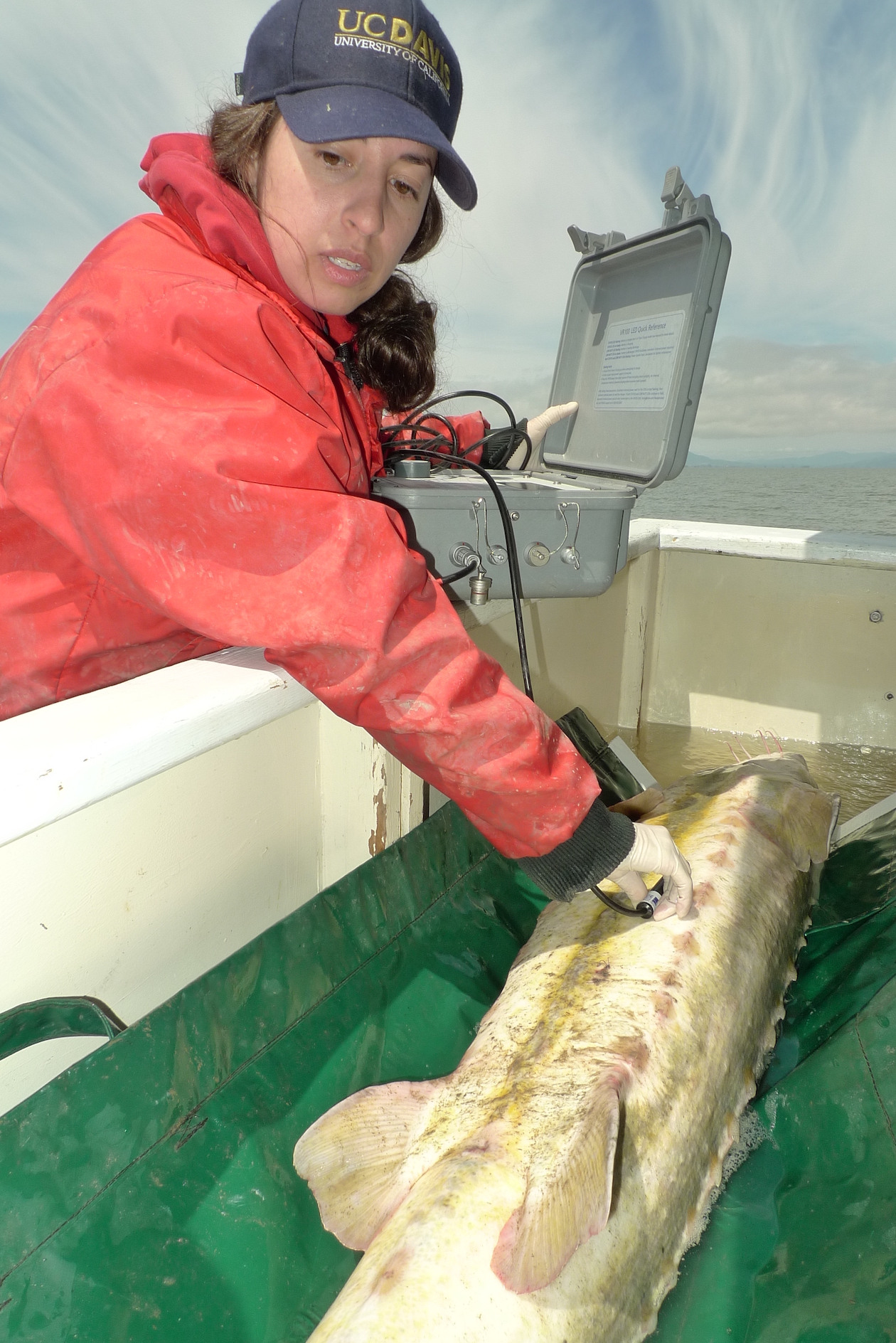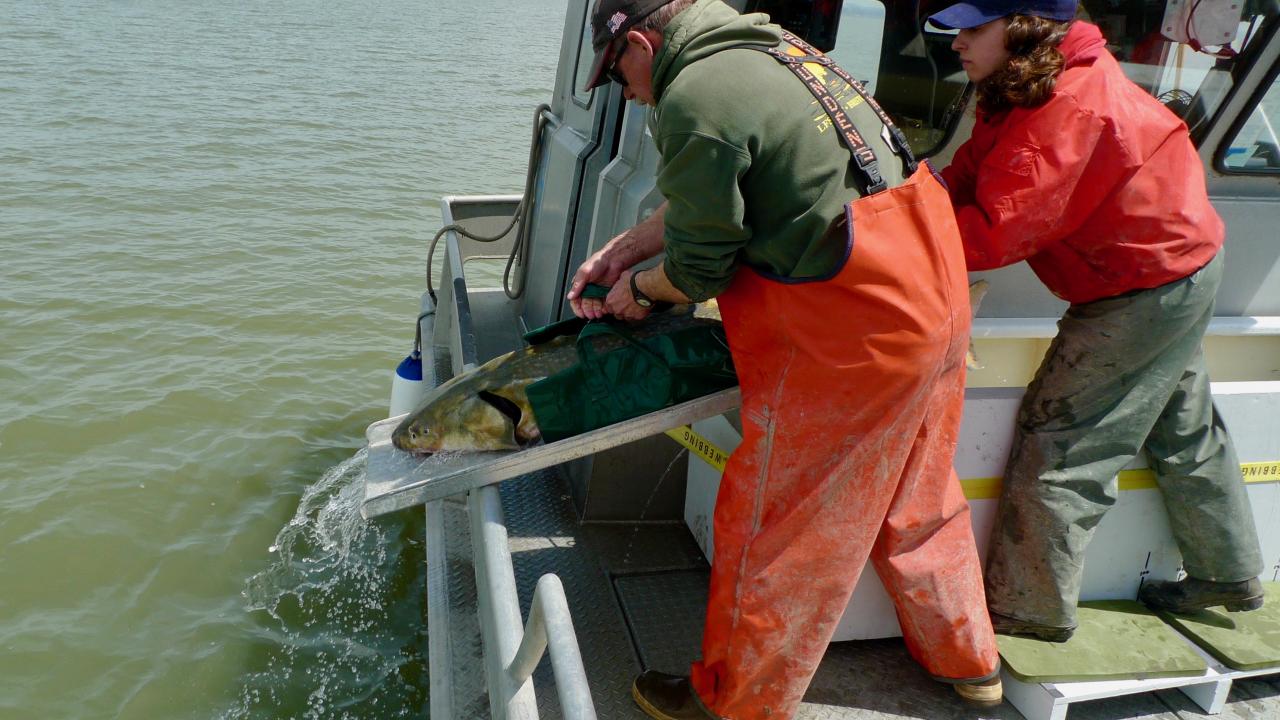The slime-coated creature writhed as it slid onto my feet. The scientific technician had just gently pushed it across the back deck of the vessel to me. He had untangled it from a 200-fathom gillnet being reeled in and now had his sights set on delicately removing an entangled bat ray that was threatening him with its venomous spine. I was up.
I quickly scooped up the squirming, three-and-a-half-foot long, dinosaur-like fish.
Big fish
Sturgeon are ancient fish that people sometimes mistake for sharks because of their asymmetrically lobed tail and elongated body. And, they can get big. White sturgeon historically reached 20 feet long and weighed nearly a ton. Now the largest fish are 12 or so feet.
Over my years of tagging, I have frequently seen six-foot-long adults, and those giants are impressive. I cannot imagine them reaching 20 feet. Their size makes more sense when you know that sturgeon can live more than 80 years and spawn repeatedly in their lifetimes.
White sturgeon, like this fish I was about to tag, are semi-anadromous. They are generally restricted to the San Francisco Bay but migrate into freshwater to spawn, like salmon or lampreys.
If white sturgeon are our resident hippos, green sturgeon are the great migration of wildebeests. Fully anadromous, green sturgeon are thought to spend more time in the ocean than any of the 25-plus sturgeon species. Like white sturgeon, they are born in the Sacramento River and rear in the San Francisco Estuary, but when green sturgeon are still immature, they exit the Golden Gate bridge, travel north along the Pacific Coast and spend adulthood feeding in the rich waters along Washington and British Columbia. They periodically migrate down to the San Francisco Bay and up the Sacramento River to spawn, even farther upriver than the white sturgeon.
My first time as a sturgeon surgeon
The white sturgeon in my arms was heavy. Its twisting body made me lurch as I brought it up to our tagging cradle.

I had helped others tag and release sturgeon before, passing the transmitter or scalpel when called upon. But this was my first time as surgeon. I had rehearsed my surgeries on orange peels, foam rubber, and dead fish. My stitches were precise; my practiced movements were continuous and reflexive; and I had become efficient. I was more than ready.
I laid the fish into the cradle and took its measurements. The smooth, scaleless skin felt rubbery. It thrashed its muscular tail, and I calmed it with my forearms. The razor scutes—the reptilian rows of bony armored plates running down the lengths of its body—sliced my gloves and the skin at my wrists, but it was a dull sting. Other tasks were front of mind.
I rolled the fish onto its back, fitting snuggly in the cradle. It immediately stopped wriggling. Like sharks, sturgeon exhibit tonic immobility, a natural state of paralysis when in a certain position. The pumped water flowed over the fish’s gills. I sterilized the skin, made my incision, and inserted the chapstick-sized transmitter into the body cavity. I neatly stitched up the incision with surgeon’s knots using absorbable sutures, then I trimmed the ends.
“All clear,” I called, and scooped the fish out of the cradle, turned it on its stomach, and lowered it off the side of the boat with the help of my fellow researcher. It gave a final kick of the tail and disappeared into the calm water of San Pablo Bay.
The white sturgeon in my arms was heavy. Its twisting body made me lurch.
This white sturgeon was not yet mature enough to spawn. It would spend several years cruising around San Pablo, Suisun, and San Francisco bays, sucking up clams with its vacuum-like mouth and crushing their shells with its muscular gizzard. All that time, the transmitter I placed inside it would ping its unique coded number, which would be detected by acoustic receivers our Biotelemetry Lab fixed on weight plates or bridge abutments from the Golden Gate Bridge all the way up the Sacramento River.
We would know every time this fish passed Alcatraz or under the Bay Bridge. We would know when it made the migration up the Sacramento River to spawn and when it would decide conditions were right to spawn again years later.
What we learned
It was one of more than 160 green and white sturgeon we tracked for six years for my Ph.D. dissertation with the UC Davis Department of Wildlife, Fish and Conservation Biology. Our study, published recently in the journal Environmental Biology of Fishes, is the most comprehensive description yet of green and white sturgeon in the San Francisco Estuary and Sacramento River.

We learned that green sturgeon make long-distance migrations about once every three years to spawn. White sturgeon make their shorter journey nearly every year.
We learned that the journey to spawn is exhausting. Despite most green sturgeon moving quickly through the freshwater system to get back to their marine feeding grounds, about 5 percent of migrating green sturgeon took more than 300 days to recover from spawning. They hunkered in deep river holes. It was previously thought that they did not eat at all when in freshwater. Now we think that cannot be true. Green sturgeon are considered the most marine of all sturgeon, so it is important to understand how they use freshwater.
Understanding these two species better, and where they are when, is valuable for agencies working to minimize human disturbances to sturgeon during activities like channel dredging and levee repairs.

From left, Michael Holm, Emily Miller and junior specialist Myfanwy Johnston of UC Davis catch a white sturgeon during a tagging expedition. (Bryan Begun/NOAA)
Sturgeon are the largest fish in the San Francisco Estuary and Sacramento River year-round. They are predators and important indicators of our ecosystem’s health. If too much water is extracted from the system or released at an unnatural time of year, like the summer, there will not be the right cues for sturgeon to successfully migrate. There also would not be enough healthy clams, crustaceans and fish to support their massive bodies, and we would see their populations drop.
Luckily, state and federal agencies monitor sturgeon populations and can use science-based management to ensure their persistence amid competing interests. This work needs to continue.
Our work would not have been possible without our collaborator, the California Department of Fish and Wildlife, boat operator Michael Holm, generous funding from U.S. Army Corps of Engineers, and the collaboration of multiple agencies involved in operating the receiver array, including National Oceanic and Atmospheric Administration, U.S. Geological Survey, U.S. Bureau of Reclamation, California Department of Water Resources, and several consulting firms.
Hidden migrations
These ancient leviathans are making their hidden migrations under bridges of unknowing commuters every day. I will never forget seeing in our data a small juvenile green sturgeon’s first adventure into marine waters during a brief trip out the Golden Gate Bridge to Point Reyes and back. I also got to document a subadult white sturgeon’s rare foray into the ocean before returning to the safety of the San Francisco Bay.
I feel lucky that I got a window into their lives. I like to imagine where they are right now.
Media Resources
Emily Miller is a researcher at Monterey Bay Aquarium Research Institute. She recently graduated with a Ph.D. in Ecology from UC Davis. Follow her on Twitter at @SturgeonSurgeon.
